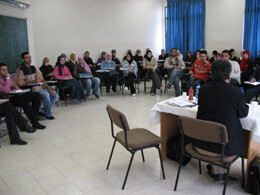The Electronic Intifada 18 December 2007

Students at the Arab American University - Jenin. (Rima Merriman)
The occasion had brought together important representatives (at the level of Deans and VPs) from every Palestinian West Bank University. Gaza was unrepresented, however. In spite of the availability of video conferencing technology at BZU in the very room where the workshop took place, there was no video hook-up with any university in Gaza for reasons better known to AMIDEAST.
The workshop was scheduled at 1:00 pm to give everybody time to get to BZU, because the West Bank is now effectively cantonized. Palestinian travel from city to city is arduous. People are forced by Israeli checkpoints and closed thoroughfares to wend their way through roundabout routes on ancient, rutted and winding back roads that go through impoverished Palestinian villages. The direct thoroughfares are chopped up and now exclusively serve illegal Israeli settlers to help them bypass the Palestinian population centers that they surround, as they travel smoothly back and forth into Israel and occupied Jerusalem. In other places, the wall the Israelis have built to mark off their territorial gains blocks travel and Palestinians are forced to zigzag around it. All this is a good lesson in geography for Palestinians, who now know intimately every obscure village in their midst.
By the time the workshop participants converged on BZU from Bethlehem, Hebron, Abu Dis, Jenin and Nablus (not quite on time), we had all been thoroughly jostled and trundled in the Ford cabs that brought us there courtesy of AMIDEAST, but we were all curious about the topic of the workshop — how to form partnerships with American universities. The presenter, a visiting Fulbright Scholar at the Institute of Law at BZU, however, talked mostly about her knowledge of issues related to overseas programs and internationalization efforts at Johns Hopkins, the university with which she is affiliated.
But most Palestinian universities are not currently in a position to invest in internationalizing or globalizing their universities in the sense that Hopkins and many other American universities are doing — i.e., in the sense of providing their students with opportunities (mostly paid for by the students themselves) that are designed to open these students up to the world at large. Nor are Palestinian universities worried right now about how to establish units to administer the hosting of foreign students in their midst and to benefit from their presence.
When Palestinians send their young people to study outside Palestine, they are looking, not so much for cultural expansion, but rather for qualifications and expertise that would allow them to earn a living. In order to pursue their higher education, Palestinians will (and do) go to every part of the world that accepts them provided money is available. They are, in fact, obliged to do so in order to pursue many fields of study at the highest levels of training. A quick poll of the Palestinian faculty and administrators at the workshop itself would have revealed that the vast majority of them got their higher degrees outside Palestine.
Some participants felt that “partnership” was the wrong term to use when referring to a relationship between Palestinian/American universities. The term “adoption” was suggested instead, so as to emphasize the one-sided relationship in the equation. But it became quickly apparent that “adoption” is too altruistic a term to use in connection with what AMIDEAST has to offer. Whatever funds AMIDEAST spends in Palestine on faculty development, it does so, as it must, in the context of a donor whose agenda (and not the agenda of the recipient) is the driving force in the relationship.
In my view, the item that is paramount on the agenda for Palestinian higher education is how to deliver a high standard of education for students in as many fields as possible, so that, in fact, they could get a first-rate education without having to leave. A high standard of education means well-administered, well-trained, well-paid faculty who have a real commitment and stake in their universities. It also means a solid basic education in Palestinian schools.
The United States Agency for International Development (USAID) selected AMIDEAST last month to implement a $9.7 million institutional capacity building project “focused on developing a school improvement network that will serve as a model for improving basic education in Palestine at both the primary and secondary level.” The same kind of money ought to be spent simultaneously on institutional capacity building for higher education in Palestine.
The conversation at the workshop veered from a discussion of partnerships between American and Palestinian universities to wondering why there was so much competition and lack of cooperation or partnering among Palestinian universities. One participant mentioned an upcoming conference at al-Najah University for the Faculties of Arts in Palestine (in February 2008). The conference will focus on exploring ways in which such faculties could work together. Let’s hope that Gaza universities will be there on video screens at al-Najah University and that West Bank participants will have the energy and stamina to begin their trek to the conference at the crack of dawn.
Rima Merriman is assistant professor and chair of the Modern Languages Department at the Arab American University - Jenin.




